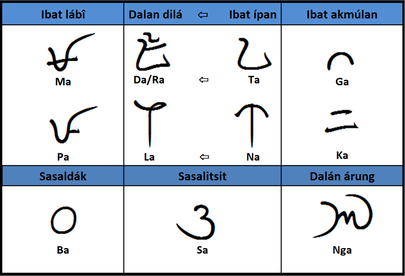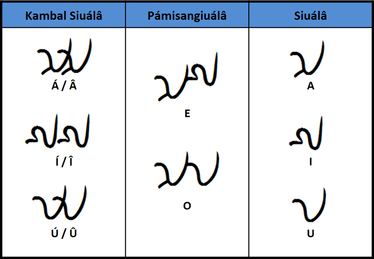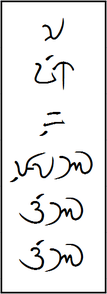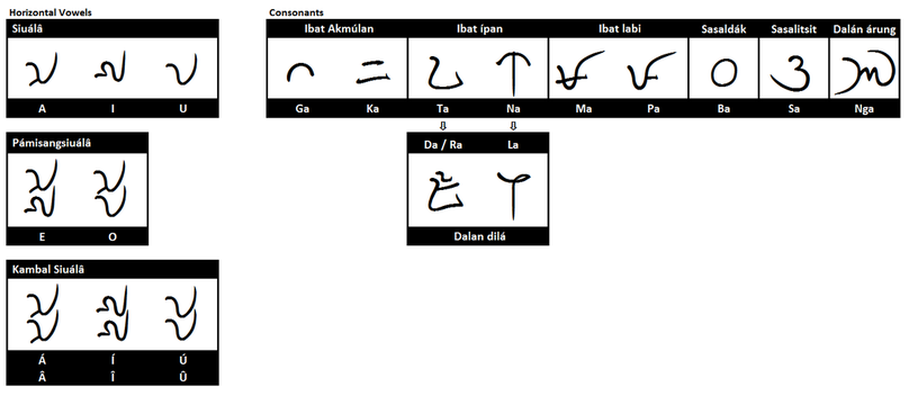Introduction of the Kapamángan script

⇦ Click image to join Kulitan Forum on Facebook
For more Information about the Kapampangan script click here:
kulitan the indigenous kapampangan script by Michael Raymon M. Pangilinan
or visit http://www.siuala.com
kulitan the indigenous kapampangan script by Michael Raymon M. Pangilinan
or visit http://www.siuala.com
Vertical chart
Súlat Kapampángan, also known as Culit, Kulitan and Pamagkulit is an indigenous writing system of the Kapampangan people, Sulat Kapampangan is an abugida or alphasyllabary, where the consonantal characters possess a inherent vowel sound that can be change with use of diacritical marks, Sulat Kapampangan can be written left to right and below to down note that Sulat Kapampangan has rules on each direction, above image is a chart for vertical writing.
Brief Introduction of Kulitan
Vowels
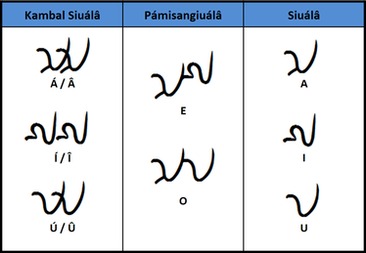
The Kapampangan script has three basic vowels / A, I and U / and two monophthongized diphthongs / E and O / (left, image)
Kambal Siula or twin vowels in Romanised Kapampangan are written with the diacritic
( ´ ) above the vowel when in medial position, indicating a lengthened vowel sound.
They are written with the diacritic (^) above the vowel when in the final position,
indicating a glottal stop. (source)
Consonants
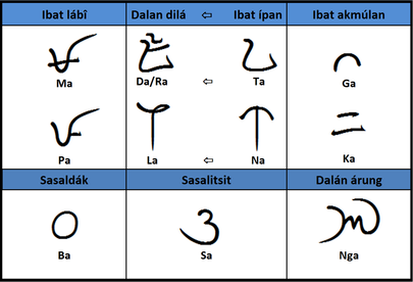
The Kapampangan script has eleven basic consonants (left, image)
2 Valor - Ga and Ka
5 Alveolar - Ta, Da/Ra, Na, La and Sa
3 Bilabials - Ma, Pa and Ba
1 Nasal Valor - Nga
Writing Kapampángan in Vertical
Changing the inherent /a/ vowel sound
Changin the inherent 'A' sound to 'I'

To change the inherent ‘A’ sound of any of the consonantal characters to ‘I’, simply place a
GARLIT ‘dot’ or ‘stroke’ above it. For example, Sa becomes Si by placing a stroke above it.
Changing the inherent 'A' sound to 'U;

To change the default ‘A’ sound of any of the consonantal characters to ‘U’, simply place a
GARLIT ‘dot’ or ‘stroke’ below it. For example, Sa becomes Su by placing a stroke below it.
Changing the inherent 'A' sound to 'E'

Since the Kapampangan sound ‘E’ was created from the monophthongisation of the diphthong ‘AI’, simply place the vowel character I right next to it, to change the default ‘A’ sound of any of the consonantal characters to ‘E’.
For example, Sa becomes Se by placing the vowel character I right after it
Changing the inherent 'A' sound to 'O'

Since the Kapampangan sound ‘O’ was created from the monophthongisation of the diphthong ‘AU’, simply place the vowel character U right next to it, to change the default ‘A’ sound of any of the consonantal characters to ‘O’.
For example, Sa becomes So by placing the vowel character U right after it.
Lengthening the inherent 'A' sound

Simply add the vowel character 'A' right after it.
For example, Sa becomes medial SÁ or final SÂ by placing the vowel character 'A' right after it.
Lengthening the 'I' sound

Simply place the vowel character 'I' to a consonantal character whose default sound has already been altered to ‘I’.
For example, to make SI into SÍ or final SÎ simply add the vowel U right after it.
Lengthening the 'U' sound

Simply place the vowel character U to a consonantal character whose default sound has already been altered to ‘U’.
For example, to make SU into SÚ or final SÛ, simply add the vowel character U right after it.
Terminating the inherent 'A' sound

When writing SÚLAT KAPAMPÁNGAN vertical, simply place the intended consonantal character right next to the preceding character instead of below it. This will terminate its default vowel sound. For example: Sa + Na = San
Horizontal chart
Writing Kapampangan in Horizontal
Changing the inherent /a/ vowel sound in Horizontal
Changing the inherent 'A' sound to 'I'

To change the inherent ‘A’ sound of any of the consonantal characters to ‘I’, simply place a
GARLIT ‘dot’ or ‘stroke’ left side of it. For example, Sa becomes Si by placing a stroke
left side of the character.
Changing the inherent 'A' sound to 'U'

To change the inherent ‘A’ sound of any of the consonantal characters to ‘I’, simply place a
GARLIT ‘dot’ or ‘stroke’ right side of it. For example, Sa becomes Si by placing a stroke
right side of the character.
Changing the inherent 'A' sound to 'E'

Since the Kapampangan sound ‘E’ was created from the monophthongisation of the diphthong ‘AI’, simply place the vowel character 'I' below it, to change the default ‘A’ sound of any of the consonantal characters to ‘E’.
For example, Sa becomes Se by placing the vowel character 'I' below it
Changing the inherent 'A' sound to 'O'

Since the Kapampangan sound ‘E’ was created from the monophthongisation of the diphthong ‘AU’, simply place the vowel character 'I' below it, to change the default ‘A’ sound of any of the consonantal characters to ‘O’.
For example, Sa becomes So by placing the vowel character 'U' below it
Lengthening the inherent 'A' sound

Simply add the vowel character 'A' below it.
For example, Sa becomes medial SÁ or final SÂ by placing the vowel character 'A' right after it.
Lengthening the 'I' sound

Simply place the vowel character 'I' to a consonantal character whose default sound has already been altered to ‘I’.
For example, to make SI into SÍ or final SÎ simply add the vowel U below it.
Lengthening the 'U' sound

Simply place the vowel character U to a consonantal character whose default sound has already been altered to ‘U’.
For example, to make SU into SÚ or final SÛ, simply add the vowel character U below it.
Terminating the inherent 'A' sound
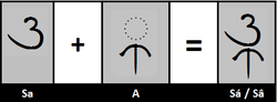
When writing SÚLAT KAPAMPÁNGAN horizontal, simply place the intended consonantal character below to the preceding character. This will terminate its inherent vowel sound.
For example: Sa + Na = San

